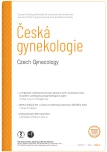Barriers to the cervical cancer screening attendance among Czech women
Authors:
A. Altová 1
; M. Lustigová 2
Authors‘ workplace:
Katedra demografie a geodemografie, Přírodovědecká fakulta, UK Praha
1; Katedra sociální geografie a regionálního rozvoje, Přírodovědecká fakulta, UK Praha
2
Published in:
Ceska Gynekol 2022; 87(4): 239-244
Category:
Original Article
doi:
https://doi.org/10.48095/cccg2022239
Overview
Objective: The main aim of this study was to find specific barriers to cervical cancer screening attendance that Czech women declare. Furthermore, the objective was to find out whether there are differences between women who do and do not attend screening according to sociodemographic characteristics. Finally, we investigated whether women who do not attend the screening differ by sociodemographic characteristics in declaring particular barriers to attendance. Materials and methods: Data were collected using a representative questionnaire survey. The women were asked about their previous participation in the cervical cancer screening program. Those who did not attend screening in the past 2 years or those who do not (intend to) attend screening regularly were considered non-attendees. The non-attendees were then asked about their reasons for non-attendance in the screening. First, descriptive statistical methods were used to analyze the data. Second, the differences between the different groups of women were analyzed by Pearson‘s chi-squared independence test. Results: In the studied sample population (N = 902), 36.7% were considered non-attendees. Statistically significant differences in sociodemographic characteristics (age, education, marital status, household type) were observed between attendees and non-attendees. The three most common reasons for non-attendance were: “I do not experience any symptoms”, “fear of cancer diagnosis”, and “fear of the examination procedure”. Almost no differences in sociodemographic characteristics in the declaration of particular barriers to attendance were found. Conclusion: We observed differences between women who attended and those who did not attend the screening. However, sociodemographic characteristics do not play an important role once a woman decides not to attend the screening. Therefore, it is essential to communicate cancer prevention throughout the spectrum of Czech women.
Keywords:
prevention – screening – barriers – cervical carcinoma – early detection of disease
Sources
1. Jansen EE, Zielonke N, Gini A et al. Effect of organised cervical cancer screening on cervical cancer mortality in Europe: a systematic review. Eur J Cancer 2020; 127 : 207–233. doi: 10.1016/j.ejca.2019.12.013.
2. Arbyn M, Anttila A, Jordan J et al. European guidelines for quality assurance in cervical cancer screening. Second Edition. Luxembourg: Office for Official Publications of the European Union. 2008 [online]. Available form: https: //screening.iarc.fr/doc/ND7007117ENC_002.pdf.
3. Májek O, Ngo O, Bučková B et al. Screening karcinomu děložního hrdla: silné a slabé stránky dle dostupných dat. 2022 [online]. Dostupné z: https: //docplayer.cz/105996301-Screening-karcinomu-delozniho-hrdla-silne-a-slabe-stranky-dle-dostupnych-dat.html.
4. Ponti A, Anttila A, Ronco G et al. Cancer Screening in the European Union. Report on the imple - mentation of the Council Recommendation on cancer screening. 2017 [online]. Available from: https: //screening.iarc.fr/EUreport.php.
5. Dušková J, Beková A, Dvořák V et al. Výsledky Národního programu screeningu karcinomu děložního hrdla v České republice. Klin Onkol 2014; 27 (Suppl 2): 79–86. doi: 10.14735/amko20142S79.
6. Altová A, Kulhánová I, Brůha L et al. Brest and cervical cancer screening attendance among Czech women. Cent Eur J Public Health 2021; 29 (2): 90–95. doi: 10.21101/cejph.a6623.
7. Broberg G, Wang J, Östberg AL et al. Socio-economic and demographic determinants affecting participation in the Swedish cervical screening program: a population-based case-control study. PloS One 2018; 13 (1): e0190171. Doi: 10.1371/journal.pone.0190171.
8. Bennett KF, Waller J, Chorley AJ et al. Barriers to cervical screening and interest in self-sampling among women who actively decline screening. J Med Screen 2018; 25 (4): 211–217. doi: 10.1177/0969141318767471.
9. Marlow L, McBride E, Varnes L et al. Barriers to cervical screening among older women from hard-to-reach groups: a qualitative study in England. BMC Womens Health 2019; 19 (1): 38. doi: 10.1186/s12905-019-0736-z.
10. Willems B, Bracke P. The education gradient in cancer screening participation: a consistent phenomenon across Europe? Int J Public Health 2018; 63 (1): 93–103. doi: 10.1007/s000 38-017-1045-7.
11. Petkeviciene J, Ivanauskiene R, Klumbiene J. Sociodemographic and lifestyle determinants of non-attendance for cervical cancer screening in Lithuania, 2006–2014. Public Health 2018; 156 : 79–86. doi: 10.1016/j.puhe.2017.12.014.
12. Gianino MM, Lenzi J, Bonaudo M et al. Organized screening programmes for breast and cervical cancer in 17 EU countries: trajectories of attendance rates. BMC Public Health 2018; 18 (1): 1236. doi: 10.1186/s12889-018-6155-5.
13. Mancuso JM. Health literacy: a concept/dimensional analysis. Nurs Health Sci 2008; 10 (3): 248–255. doi: 10.1111/J.1442-2018. 2008.00394.X.
14. Kim K, Han HR. Potential links between health literacy and cervical cancer screening behaviors: a systematic review. Psychooncology 2016; 25 (2): 122–130. doi: 10.1002/pon.3883.
15. Taber JM, Leyva B, Persoskie A. Why do people avoid medical care? A qualitative study using national data. J Gen Intern Med 2015; 30 (3): 290–297. doi: 10.1007/S11606-014-3089-1.
16. Moser RP, Arndt J, Han PK et al. Perceptions of cancer as a death sentence: prevalence and consequences. J Health Psychol 2014; 19 (12): 1518–1524. doi: 10.1177/1359105313494924.
17. Wilding S, Wighton S, Halligan D et al. What factors are most influential in increasing cervical cancer screening attendance? An online study of UK-based women. Health Psychol Behav Med 2020; 8 (1): 314–328. doi: 10.1080/21642850.2020.1798239.
18. O projektu – Optimalizace programu screeningu karcinomu děložního hrdla zavedením detekce genomu lidského papilomaviru pomocí samoodběrových sad u žen dlouhodobě se neúčastnících stávajícího screeningu. 2022 [online]. Dostupné z: https: //nsc.uzis.cz/zdravy cipek/ index.php?pg=o-projektu.
Labels
Paediatric gynaecology Gynaecology and obstetrics Reproduction medicineArticle was published in
Czech Gynaecology

2022 Issue 4
Most read in this issue
- Uterine perforation during intrauterine procedures and its management
- Uterus sparing surgery in adenomyosis and its impact on reproductive outcomes
- Amniotic fluid embolism – review and multicentric case analysis
- Cesarean scar pregnancy – a retrospective analysis of cases in the years 2012–2021
